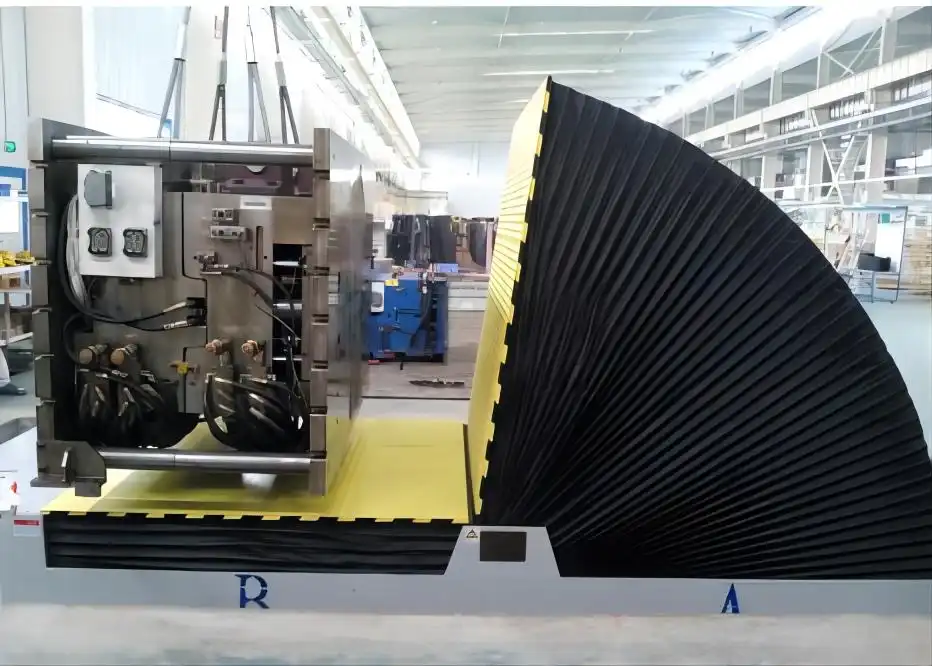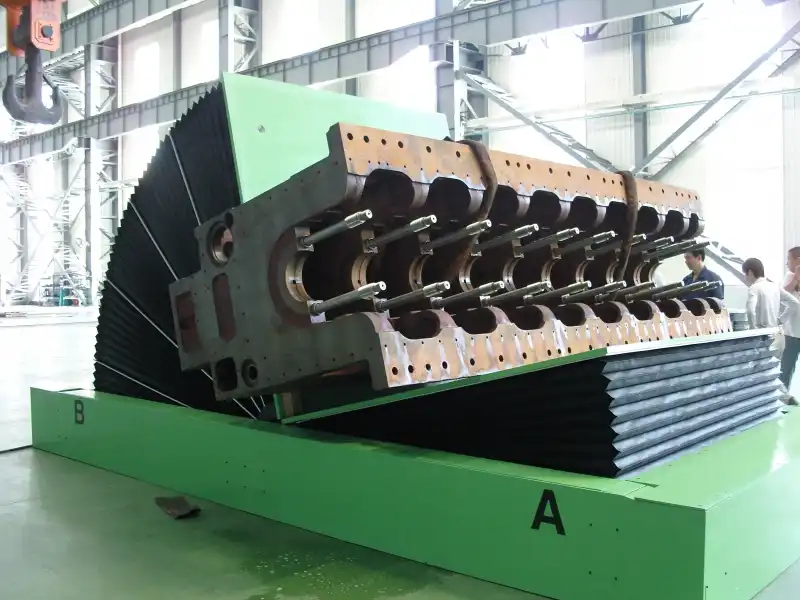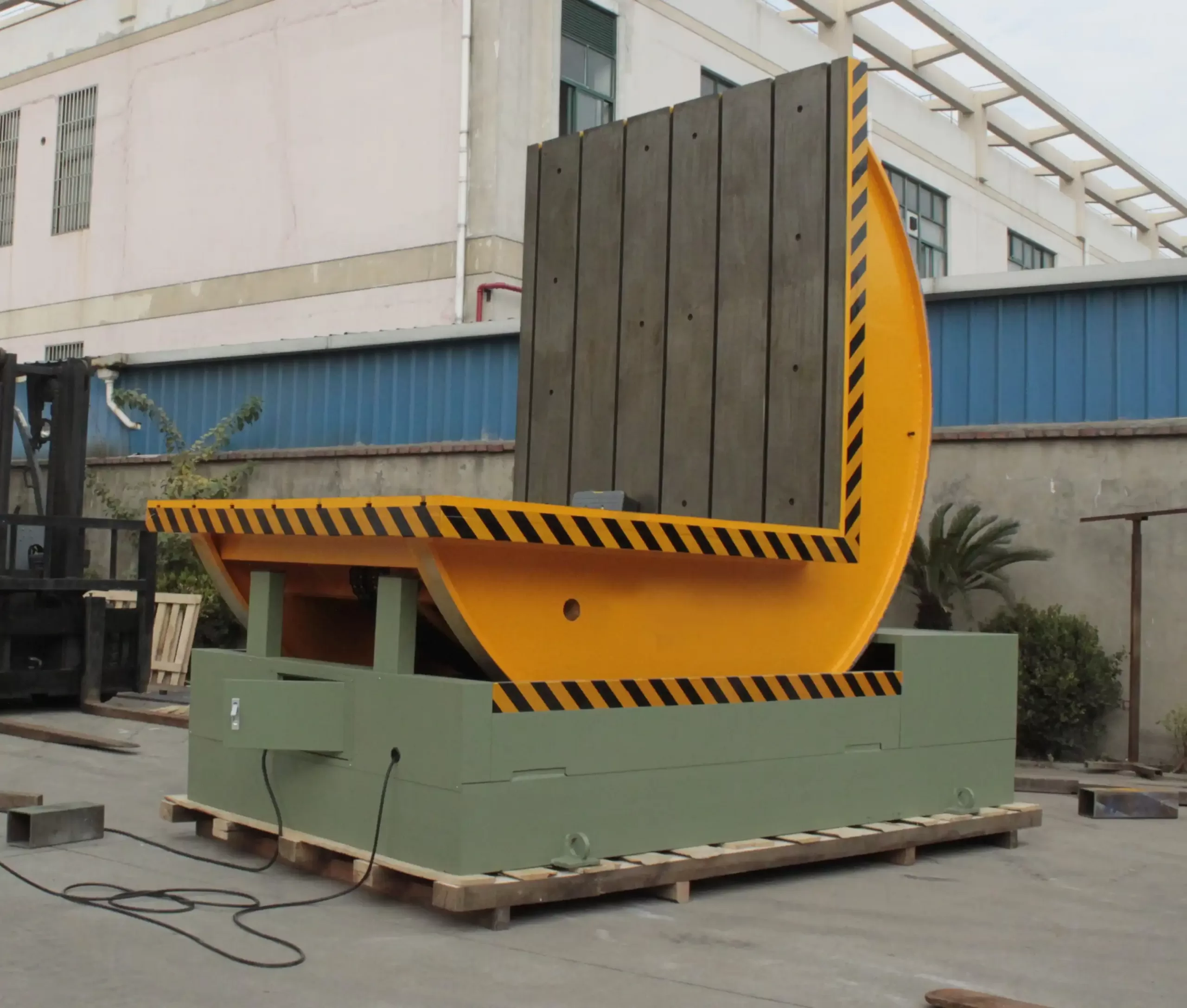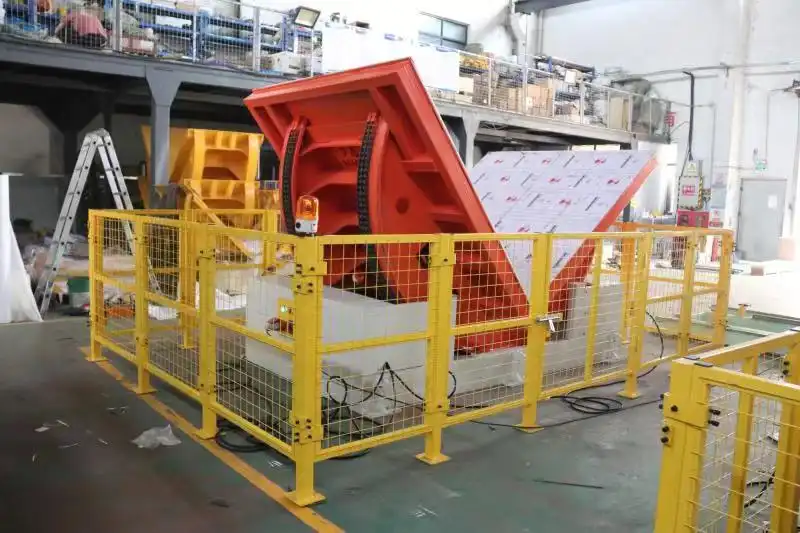In heavy industries across Brazil, from automotive to steel manufacturing, molds are the heart of production. They are incredibly heavy, expensive, and delicate. Flipping them for maintenance or setup using cranes and chains is a high-stakes gamble. One slip can mean a damaged mold, a shattered production schedule, and a huge financial hit. I've seen it happen. A factory manager calls me in a panic because a multi-ton mold has been dropped. The damage isn't just the repair cost. It's the weeks of downtime, the delayed orders, and the idle workforce that truly hurt the business. This is a recurring nightmare for many Brazilian plant owners who are trying to balance efficiency with safety. There is a much safer, more reliable way. A dedicated mold upender, or flipper, is a machine designed for one purpose: to turn heavy objects 90 degrees with perfect control. It's a total solution that protects your investment and keeps your production line moving.
Brazilian companies can avoid costly damage and downtime in mold flipping by transitioning from high-risk manual methods, like using cranes and slings, to specialized mechanical mold upenders. These machines provide a stable platform and controlled rotation, eliminating the primary causes of accidents such as slipping, dropping, and shock-loading, thereby safeguarding valuable molds and ensuring continuous production.

It sounds simple, but the impact is profound. Moving from a risky, manual process to a controlled, automated one changes everything. But what are the true costs you're avoiding? And how does this single piece of equipment actually boost your overall efficiency? As someone who has built my career from the factory floor up, I want to break down the mechanics and the business case for making this critical upgrade. Let's dive deeper.
What are the Real Costs of Improper Mold Handling?
Many managers in Brazil look at the price of a new mold upender and hesitate. They see a capital expense. But they often fail to calculate the enormous, and often hidden, costs associated with not having one. A single incident with a mold is never just a single line item on a budget. The problem cascades. A damaged mold surface means scrapped parts. A cracked mold body means emergency repairs or a complete replacement, which can take months. While you wait, your production line is either down or running at a fraction of its capacity. The financial bleeding goes far beyond the initial repair bill. By understanding the full spectrum of costs—both direct and indirect—the decision becomes clear. Investing in proper handling equipment is not a cost; it's an insurance policy against catastrophic financial and operational failure.
The real costs of improper mold handling extend far beyond simple repair expenses. They include direct costs like mold replacement and labor for repairs, and more significant indirect costs such as production downtime, lost revenue from delayed orders, scrapped products, and potential reputational damage in the competitive Brazilian market.

Breaking Down the Financial Impact
When we only look at the immediate bill for fixing a dropped mold, we are missing the bigger picture. In my experience, the true cost is often 5 to 10 times the repair cost itself. These hidden expenses are what can truly cripple a factory's profitability. Let's separate them into two categories to understand them better.
Direct Costs: The Tip of the Iceberg
These are the obvious expenses you see right away.
- Repair or Replacement: A large industrial mold can cost tens or even hundreds of thousands of dollars. A major crack or deformation might mean a full replacement is the only option. Even "minor" surface damage requires specialized welding, machining, and polishing, which is both expensive and time-consuming.
- Labor Costs: You have to pay your maintenance team or external specialists for the repair work. This often includes overtime pay to get the production line back up as quickly as possible.
- Logistics: The damaged mold may need to be transported to a specialized repair facility. The cost of shipping a multi-ton object safely can be significant, especially in a large country like Brazil.
Indirect Costs: The Hidden Killer
These are the costs that ripple through your entire operation. They are harder to quantify but are far more damaging.
- Production Downtime: This is the biggest cost. Every hour your production line is stopped, you are losing money. Calculate your revenue per hour, and you'll see how quickly this adds up.
- Lost Orders and Penalties: If you can't deliver to your clients on time, you may face contractual penalties. Worse, you risk losing that client to a more reliable competitor. Your reputation for dependability is priceless.
- Wasted Material: Before the damage was noticed, you may have produced a batch of faulty parts. All of that material, energy, and labor is now scrap.
- Employee Morale and Safety: An accident or near-miss creates a stressful work environment. Workers become hesitant and slow, and the risk of another incident can increase.
Here is a simple table to visualize the financial damage from a single mold-dropping incident.
| Cost Category | Description | Estimated Financial Impact (Example) |
|---|---|---|
| Direct Costs | ||
| Mold Repair | Cost to weld, machine, and polish the damaged mold. | R$ 50,000 |
| Labor | Overtime for the in-house maintenance team. | R$ 10,000 |
| Indirect Costs | ||
| Production Loss | 48 hours of downtime on a line that generates R$ 20,000/hour. | R$ 960,000 |
| Lost Orders | Penalty for one delayed shipment to a major automotive client. | R$ 100,000 |
| Scrapped Product | Value of defective parts produced before the issue was caught. | R$ 25,000 |
| Total Impact | R$ 1,145,000 |
As you can see, the initial repair cost is a tiny fraction of the total business impact. An investment in a proper mold upender, which might cost a fraction of this total, suddenly looks like a very smart business decision.
How Does a Mechanical Mold Upender Improve Safety and Efficiency?
Using an overhead crane to flip a mold is a common practice in many Brazilian factories. It feels fast. But it's a process filled with variables and risks. Chains can slip, the center of gravity can shift unexpectedly, and the operator's skill is the only thing preventing a disaster. Every time a mold is flipped this way, you're not just risking the equipment; you're risking your people. A falling mold is a life-threatening event. Even near-misses create a culture of fear and slow down operations as workers become overly cautious, and rightfully so. This is not an efficient or sustainable way to work. A mechanical mold upender removes these variables. It provides a stable, predictable, and safe environment for turning heavy loads. This frees your team to work confidently and transforms a high-risk task into a routine, push-button operation.
A mechanical mold upender dramatically improves safety and efficiency by replacing dangerous, manual flipping with a controlled, automated 90-degree rotation. This eliminates the risk of dropped loads, protecting both personnel and expensive molds, while significantly reducing the time and manpower required for the task, boosting overall operational throughput.

Transforming a High-Risk Task into a Routine Operation
When I visit factories, I often see the same risky procedure. Two or three workers gather around a massive mold. They attach heavy chains and slings, communicating with hand signals to a crane operator who might have a limited view. The mold lifts, swings, and slowly turns in mid-air. Everyone holds their breath. This process is not just unsafe; it's incredibly inefficient. The entire operation relies on human judgment and coordination, where a small mistake can have massive consequences.
The Old Way: The Dangers of Crane Flipping
The traditional method is flawed for several reasons.
- Instability: A hanging load's center of gravity is hard to control. As it turns, it can suddenly shift, causing the mold to swing violently or slip from its bindings.
- Shock Loading: When the mold is set down after flipping, it's difficult to do so gently. The impact can cause micro-fractures or misalignments that damage the mold over time.
- Personnel Risk: The most significant issue is the danger to your employees. They must work directly under and around a suspended multi-ton load. This is a risk that is unacceptable in a modern industrial environment.
- Time and Labor Intensive: This process requires a skilled crane operator and at least two riggers on the ground. It can take 20-30 minutes of careful, tense work for a single flip.
The New Way: The Certainty of a Mold Upender
A mechanical mold upender changes the entire dynamic.
- Stability and Control: The mold is loaded onto a stable platform at ground level. The machine, powered by a robust hydraulic or electromechanical system, performs a smooth, controlled 90-degree rotation. There is no swinging, no dropping, no shock.
- Operator Safety: The entire process is controlled by a single operator from a safe distance using a simple push-button panel or remote control. No one needs to be near the moving load.
- Efficiency: What took 20-30 minutes with a team of three now takes 2-3 minutes with a single operator. This time saving, repeated over hundreds of mold changes a year, adds up to a significant increase in productivity. Your skilled crane operator and riggers are now free to perform other value-added tasks.
This table clearly compares the two methods.
| Feature | Crane and Chain Flipping (Old Way) | Mechanical Mold Upender (New Way) |
|---|---|---|
| Safety | High risk of dropped loads, personnel injury | Extremely safe, load is secured, remote operation |
| Control | Relies on operator skill, poor control | Precise, smooth, and automated 90-degree rotation |
| Time per Flip | 20-30 minutes | 2-3 minutes |
| Manpower | 2-3 people (crane operator, riggers) | 1 operator |
| Mold Protection | High risk of shock, scratches, and deformation | Gentle handling, no impact or stress on the mold |
| Repeatability | Inconsistent, varies with each attempt | Perfectly consistent and repeatable every time |
The choice is clear. A mold upender is not just a safer machine; it is a fundamental process improvement that boosts efficiency and protects your most valuable assets: your people and your equipment.
What Key Features Should You Look for in a Mold Upender?
So, you're convinced that a mold upender is the right choice for your Brazilian facility. But you go online and see dozens of options. They all look similar, but the details matter. Choosing the wrong machine can mean you've just swapped one set of problems for another. I remember a client who bought a machine based on price alone. It wasn't robust enough for their heaviest molds, and the drive system failed within a year, causing even more downtime. A machine that is under-specced for your mold's weight can fail. A machine without proper safety features is a lawsuit waiting to happen. A machine with a complex control system can lead to operator error. As an engineer who has designed and built these machines, I can tell you what to look for. Focusing on a few key features will ensure you get a machine that is safe, reliable, and perfectly suited to your specific operational needs.
When selecting a mold upender for your Brazilian operations, look for key features such as a robust load capacity that exceeds your heaviest mold, comprehensive safety measures like limit switches and emergency stops, a stable and wide support base, smooth hydraulic or electro-mechanical drive systems, and user-friendly controls to ensure safe and reliable performance.

A Practical Checklist for Your Investment
Making the right choice is about asking the right questions and checking the specifications. A good supplier will be happy to walk you through these details. They should be a partner in your success, not just a seller. Here’s a breakdown of what I consider non-negotiable features.
Core Structural and Mechanical Features
This is the foundation of the machine. It needs to be strong and reliable.
- Load Capacity: This is the most critical spec. Don't just match your heaviest mold's weight; choose a capacity that is at least 20-25% higher. This provides a safety margin and accounts for any future, heavier molds.
- Platform (Table) Size: The machine's working tables must be large enough to fully support the base of your mold. The mold should not hang over the edges, as this creates instability.
- Drive System: You typically have two choices: hydraulic or electro-mechanical. Hydraulic systems offer immense power and smooth control, ideal for very heavy loads. Electro-mechanical systems, using motors and gearboxes, are cleaner (no risk of oil leaks), require less maintenance, and offer very precise positioning. The choice depends on your specific environment and load requirements.
- Frame Construction: Look for a heavy-duty, welded steel frame. A flimsy, bolted-together frame will not withstand the immense forces involved in turning a multi-ton load over years of service.
Essential Safety and Control Systems
These features protect your people and your investment.
- Emergency Stop: There should be prominent E-stop buttons on the machine and the control panel that immediately cut all power.
- Limit Switches: These switches automatically stop the rotation at the 0 and 90-degree positions, preventing over-travel that could damage the machine or the mold.
- Overload Protection: A good system will have built-in protection to prevent an operator from trying to lift a load that exceeds the machine's capacity.
- Control Panel: It should be simple, intuitive, and durable. Clearly labeled buttons for "Forward," "Reverse," and "Stop" are better than a complex touchscreen that can be damaged in a factory environment. A remote control option provides the operator with greater flexibility and a better vantage point.
Here is a checklist you can use when talking to suppliers.
| Feature Category | Question to Ask | Look For |
|---|---|---|
| Capacity & Size | What is the maximum weight and what are the dimensions of our molds? | Capacity 25% over max weight. Tables larger than the mold base. |
| Structural Integrity | Can you show me the engineering specs for the frame and welds? | Heavy-gauge steel, certified welding, robust construction. |
| Drive System | Is a hydraulic or electro-mechanical system better for our application? | Smooth operation, no jerking. Reputable component brands (motor, gearbox). |
| Safety Features | What safety interlocks are included? Is it compliant with local Brazilian NR-12 standards? | E-stops, limit switches, overload protection, safety railings (if needed). |
| Controls | Can we see a demo of the control system? Is a remote control available? | Simple, robust buttons. Intuitive operation. |
| Maintenance | What are the routine maintenance requirements? Are spare parts readily available in Brazil? | Easy access to lubrication points and key components. Local support. |
By using this checklist, you move from being a buyer to being an informed investor, ensuring the machine you choose is a long-term asset, not a short-term liability.
How Can Integrating a Mold Upender Support Your Digital Transformation Goals?
In today's competitive market, especially in a dynamic economy like Brazil's, efficiency is not enough. The leaders are embracing digital transformation—Industry 4.0. You might think a mold upender is just a simple piece of mechanical equipment, disconnected from this larger trend. But if you see it as just a "dumb" machine, you're missing a huge opportunity. A standalone machine helps, but it doesn't feed into your larger ecosystem of data. You're still relying on manual tracking and guesswork for maintenance schedules and usage patterns, leaving you blind to potential optimizations. As a provider of "TOTAL SOLUTIONs," we see things differently. A modern mold upender can be a vital data point in your smart factory. It can be integrated into your MES and equipped with sensors to support your goals of predictive maintenance and full production visibility.
A mold upender supports digital transformation by being more than just a mechanical flipper; it can be integrated with IoT sensors and your factory's MES. This allows for real-time tracking of mold movements, cycle counts for predictive maintenance, and data collection that enhances overall production visibility and strategic planning.

From Mechanical Tool to Smart Asset
A forward-thinking leader doesn't just buy a machine; they invest in a capability. The true potential of a mold upender is unlocked when it stops being an isolated island of activity and starts communicating with your other factory systems. This is the core idea of Industry 4.0, and it's more accessible than you might think. I've worked with clients to make this happen, and the results are transformative.
Practical Integration Steps with Your MES/ERP
Your Manufacturing Execution System (MES) or Enterprise Resource Planning (ERP) system is the brain of your operation. Making your mold upender a part of this brain provides incredible insights.
- Cycle Counting: A simple sensor can be added to the upender to count every time it completes a 90-degree cycle. This data is automatically sent to your MES. Why is this important? Because now you have an accurate usage log for every single mold.
- Mold Identification: You can integrate a barcode or RFID scanner. Before flipping, the operator scans the mold's ID. Now, your system not only knows that a mold was flipped, but it knows which mold was flipped. This links the usage data directly to a specific asset.
The Long-Term Vision: Predictive Maintenance and Beyond
This is where it gets really powerful.
- Predictive Maintenance: Most factories use a time-based maintenance schedule (e.g., "service mold #102 every 6 months"). This is inefficient. A mold used heavily needs more frequent service than one used rarely. With accurate cycle counting, you can switch to a usage-based schedule ("service mold #102 every 500 cycles"). This is predictive maintenance. It reduces unnecessary servicing, prevents failures from overuse, and extends the life of your expensive molds.
- Process Optimization: The data can reveal bottlenecks. Is a certain mold type being flipped more often than others? Is the time between flips getting longer, indicating a problem elsewhere on the line? This data allows you to ask smarter questions and optimize your entire production flow.
This table shows how a "smart" upender fits into an Industry 4.0 strategy.
| Feature | Standard Mold Upender | Smart/Integrated Mold Upender | Business Benefit |
|---|---|---|---|
| Operation | Manual push-button start/stop | Operator scans mold ID; cycle starts and data is logged automatically | Eliminates manual data entry errors; creates a reliable digital record. |
| Data Collection | None. Relies on paper logs. | Automatic cycle counting and time-stamping sent to MES/ERP. | Provides accurate, real-time data for analysis. |
| Maintenance Scheduling | Time-based (e.g., every 6 months) | Condition/Usage-based (e.g., every 500 cycles) | Prevents over/under-servicing, reduces downtime, extends mold life. |
| Operational Visibility | Isolated "black box" operation | Integrated data point in the overall production flow. | Allows managers to see bottlenecks and optimize the entire process. |
| Strategic Value | A tool for a single task. | A data-generating asset that drives continuous improvement. | Supports long-term goals of digitalization and operational excellence. |
By thinking of a mold upender as a potential node in your digital network, you are not just buying a machine. You are making a strategic investment in the future intelligence and efficiency of your Brazilian factory.
Conclusion
Investing in the right mold upender is more than a purchase. It's a strategic step towards safety, efficiency, and future-proofing your Brazilian manufacturing operations.





